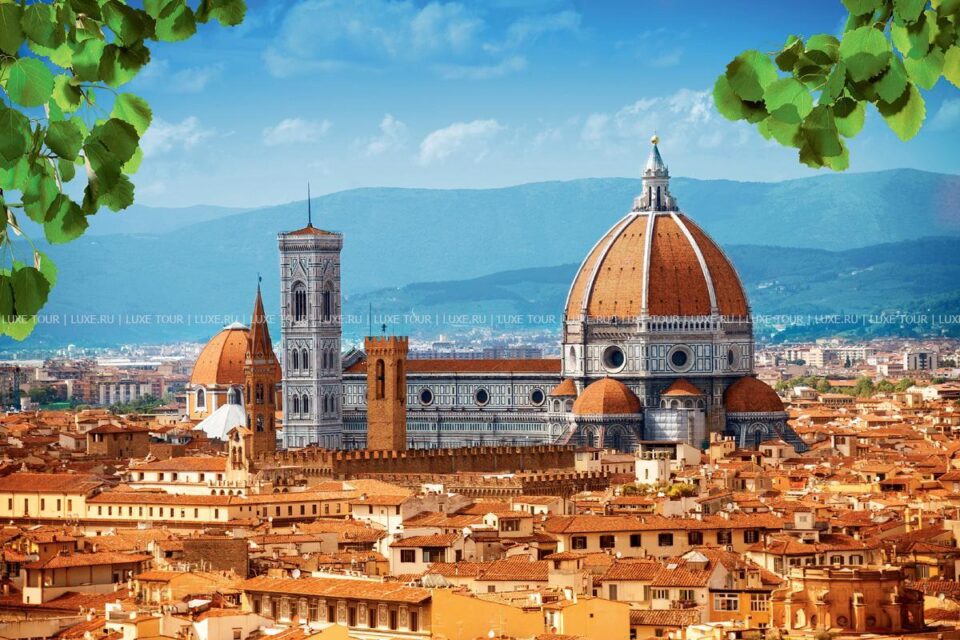Florence is considered the birthplace of the Renaissance, a period that gifted the world with invaluable masterpieces of architecture, painting, numerous poets, writers, and musicians. The atmosphere of past centuries in the city mingles with the life of modern buildings, streets, and squares. Numerous attractions, churches, and temples of Florence possess an inexplicable magical power that draws the eye and compels one to stop and enter.
Church of the Nativity of Christ and St. Nicholas the Wonderworker
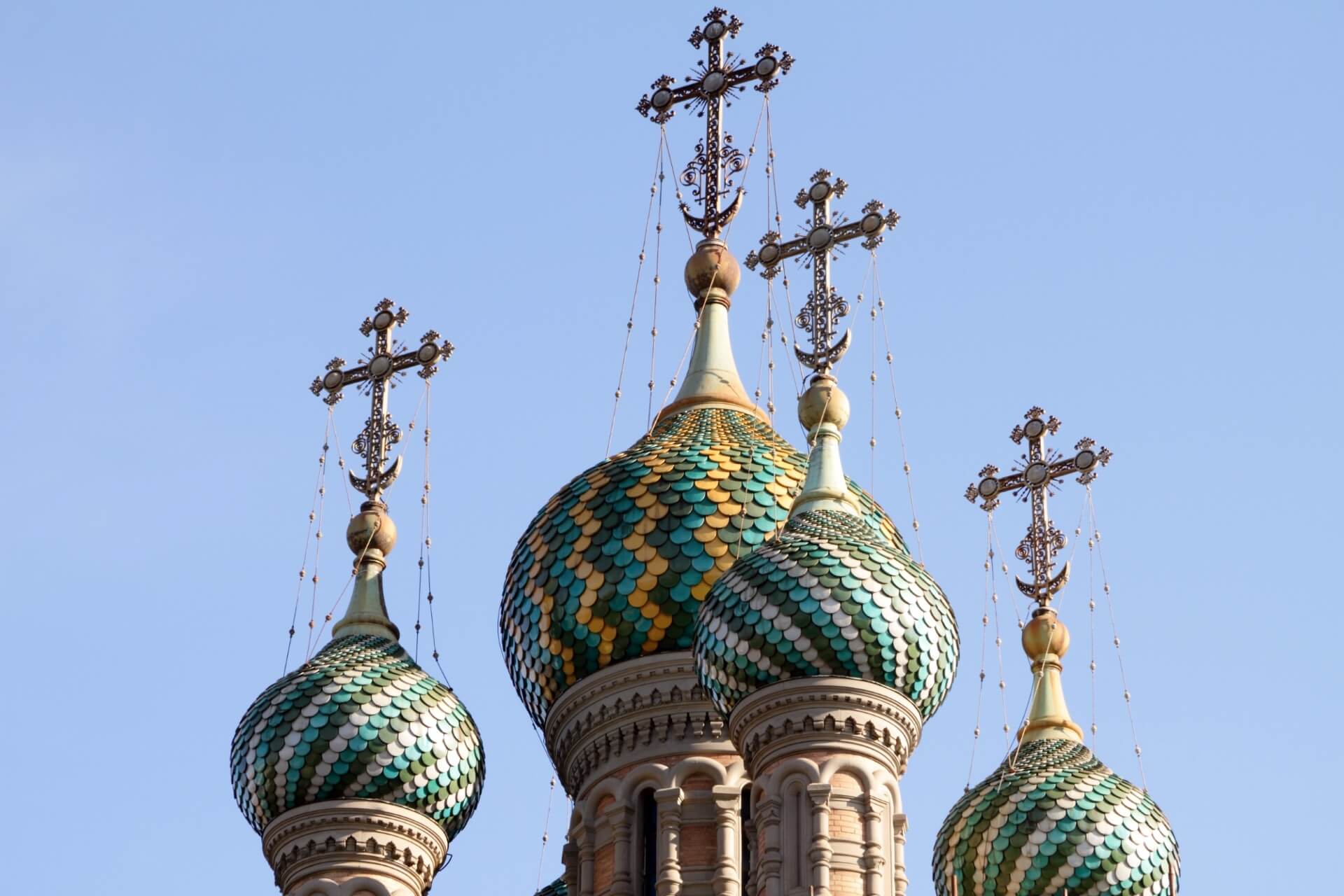
Not far from the city’s main bus station rises a five-domed church, familiar in appearance from Russian churches. The principles of Moscow-Yaroslavl architecture of the 17th century are reflected in the architecture of the church in Italy for a reason. Its history began with the acquisition of a land plot near the Munyone River by the Russian Orthodox Church. Construction, designed by Preobrazhensky, began in July 1899. The first Orthodox church in Italy has a two-story structure, a high porch, a central part decorated with kokoshniks, and traditional five domes.
The lower part of the church is dedicated to St. Nicholas the Wonderworker (consecrated in 1902). Here, there is a wooden iconostasis and many interesting icons created by specialists from Peshekhonov’s workshop. Many elements of the lower floor’s decoration were transferred from the collection of Prince P. Demidov. The upper part is dedicated to the Nativity of Christ (consecrated in 1903). It has an interesting iconostasis made of famous white marble. The wall paintings are done in the style of Russian modernism. The church holds rare relics, such as a bell from the cruiser “Admaz” that participated in the Battle of Tsushima, and the cross of Metropolitan, Patriarch of Moscow, and all Rus’ Philaret (Romanov).
Church of Santa Maria Novella
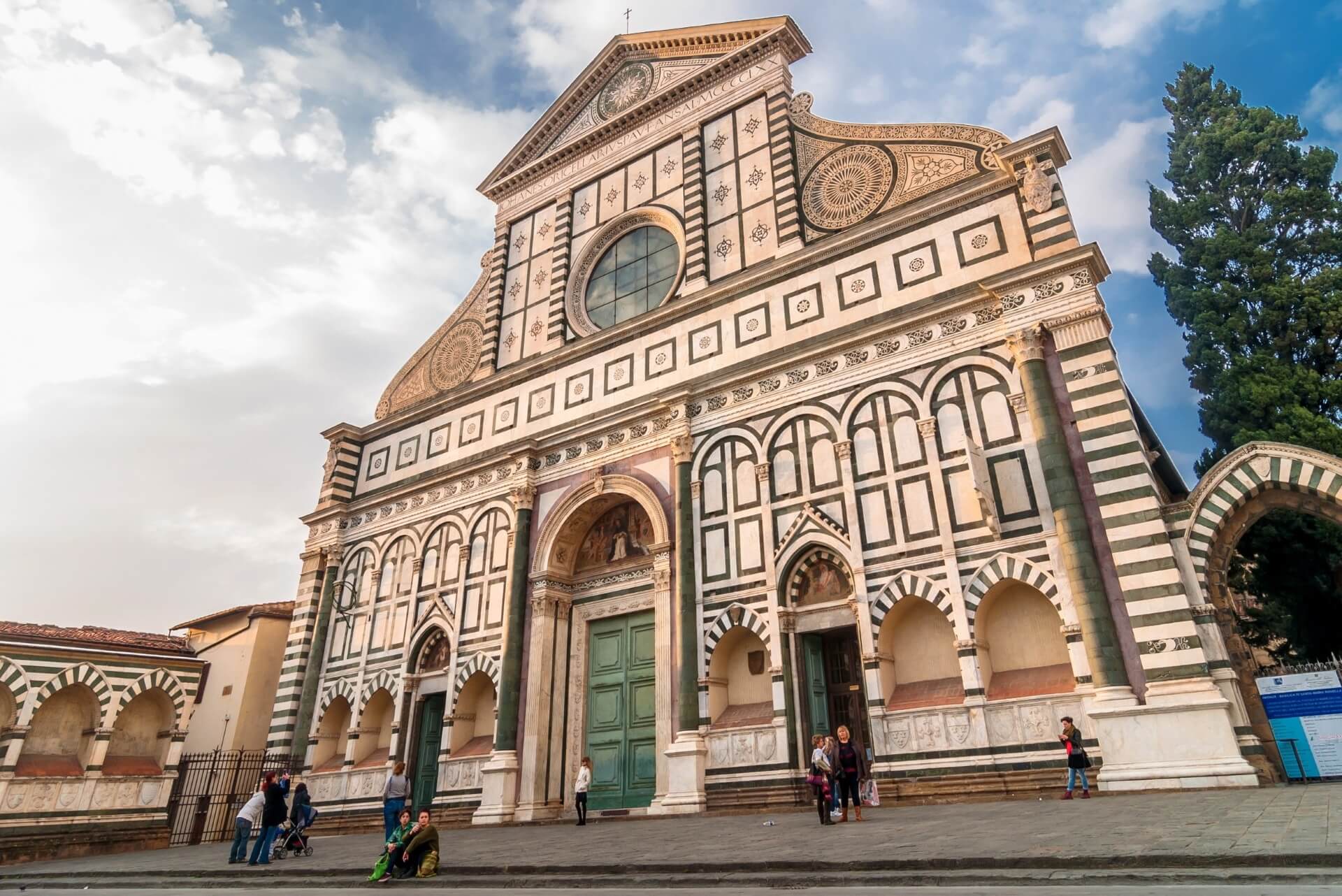
The architectural form of the building, decorated with a geometric pattern of polished marble tiles, resembles a lace box. One will definitely want to open it and look inside at first glance at the old building. Its initial role was formed by the powerful and wealthy Dominican order, which was building another monastery and church for itself. It was built on the site of the old oratory of Santa Maria delle Vigne. Construction was completed in 1420. The interesting facade of the church was commissioned by the Rucellai family. Their symbol in the form of a ship with billowing sails decorates the portal of the building.
An original element of the church is the pilasters (in the form of columns, on which there are pointed windows). The church’s interior has been changed and supplemented with new elements several times. It now features works of art from the 14th-16th centuries. Among them, you can see the monument to Blessed Villana, the tombs of Bishop of Fiesole, Filippo Strozzi, and the bust of Saint Antoninus. The altar with an interesting bronze crucifix is built in the Cappella Maggiore. In the Strozzi Chapel, you can see famous frescoes depicting the Last Judgment and other oldest frescoes of Florence.
Address: Piazza Santa Maria Novella. The church is open to visitors from 9 AM to 7 PM. The entrance fee is 5 €.
Cathedral of Santa Maria del Fiore
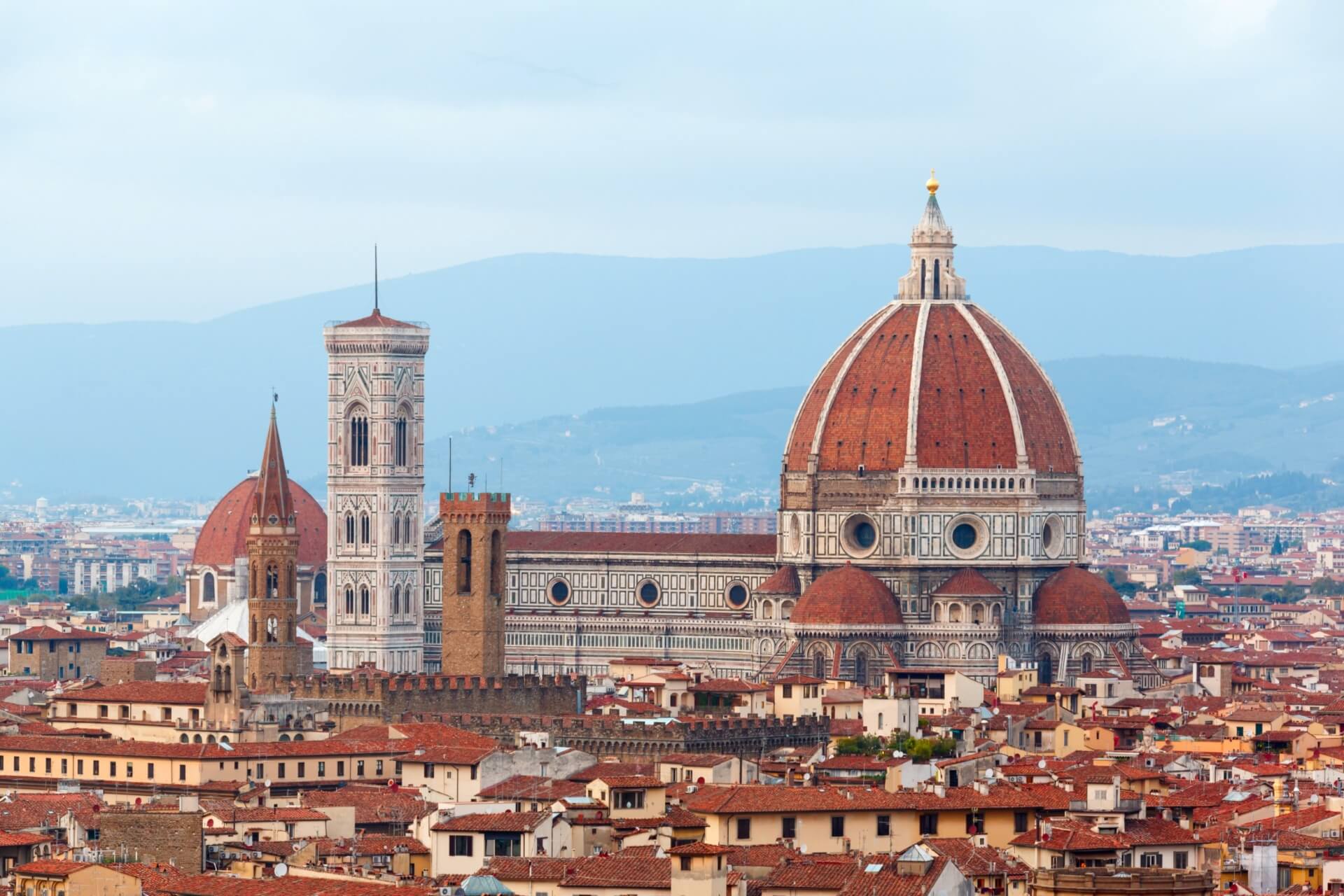
During its heyday and population growth, Florence (the capital of Tuscany) needed a cathedral demonstrating its grandeur. Such a cathedral in 1434 became the Duomo, built on the site of the ancient cathedral of Santa Reparata, which had existed for nine centuries.
At that time, it could accommodate all the city’s residents. Now the church’s dome, rising above the bright tiled roofs of the city blocks, points the way to one of Florence’s main attractions. Climbing 414 steps, you can appreciate the beauty of the surroundings from the top of the tower and walk around the majestic dome via another staircase.
The dome’s creation used the ingenious engineering solutions of architect Brunelleschi, allowing the church to stand for many centuries. Nearly 14 years were spent constructing the massive dome. Its height, along with a small temple on top serving as a lantern, is about 107 meters.
This amazing architectural element has reliably held the dome’s structure for centuries. As a result, the world is forever captivated by the view, size, and beauty of the Cathedral of Santa Maria del Fiore. The cathedral’s dimensions (length 153 m, width 90 m) have placed it fourth in the world.
Church of All Saints
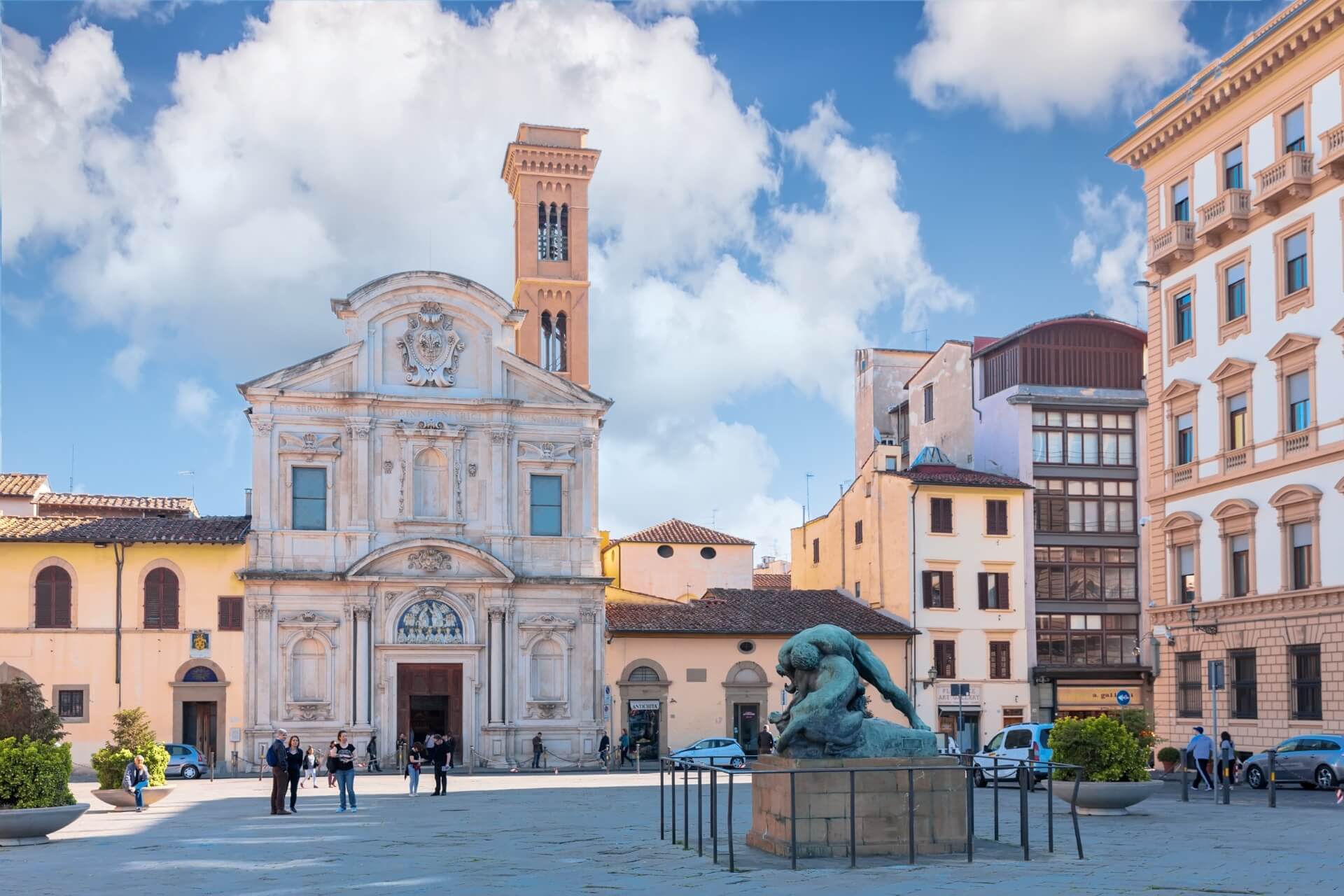
Ognissanti or the Church of All Saints participated in many historical events on its way to becoming Florence’s first basilica, involving numerous rulers. The names of famous architects and painters remain in the interesting elements of the church’s exterior and interior. For example, the creations of famous painters Botticelli and Ghirlandaio (Michelangelo’s teacher) still stun with the beauty of their extraordinary frescoes. This includes “The Last Supper,” “Madonna of Mercy,” “Saint Jerome,” and Botticelli’s “Saint Augustine,” considered a classic work of the Renaissance. Incidentally, his life is closely connected with this church, where the grave of the famous master is located.
It is situated at the feet of his beloved, Simonetta Vespucci, who is buried here. She was the wife of a relative of Amerigo Vespucci, after whom America was named. Her beautiful face is forever captured in the works of the enamored Renaissance artist (Venus, Spring on famous canvases). The church’s history is linked to the Vespucci family. Initially, it belonged to the family. The construction of the new basilica began in 1251 as a part of the Humiliati monastery complex. Thanks to the powerful financial support of Florence’s wealthy people, the church (in Baroque style) quickly accumulated masterpieces of art created by famous masters over different centuries.
Address: Borgo Ognissanti, 42, 50123 Firenze. The church is open for free from Monday to Sunday, from 7:30 AM to 7:45 PM with a break.
Basilica of Santa Croce
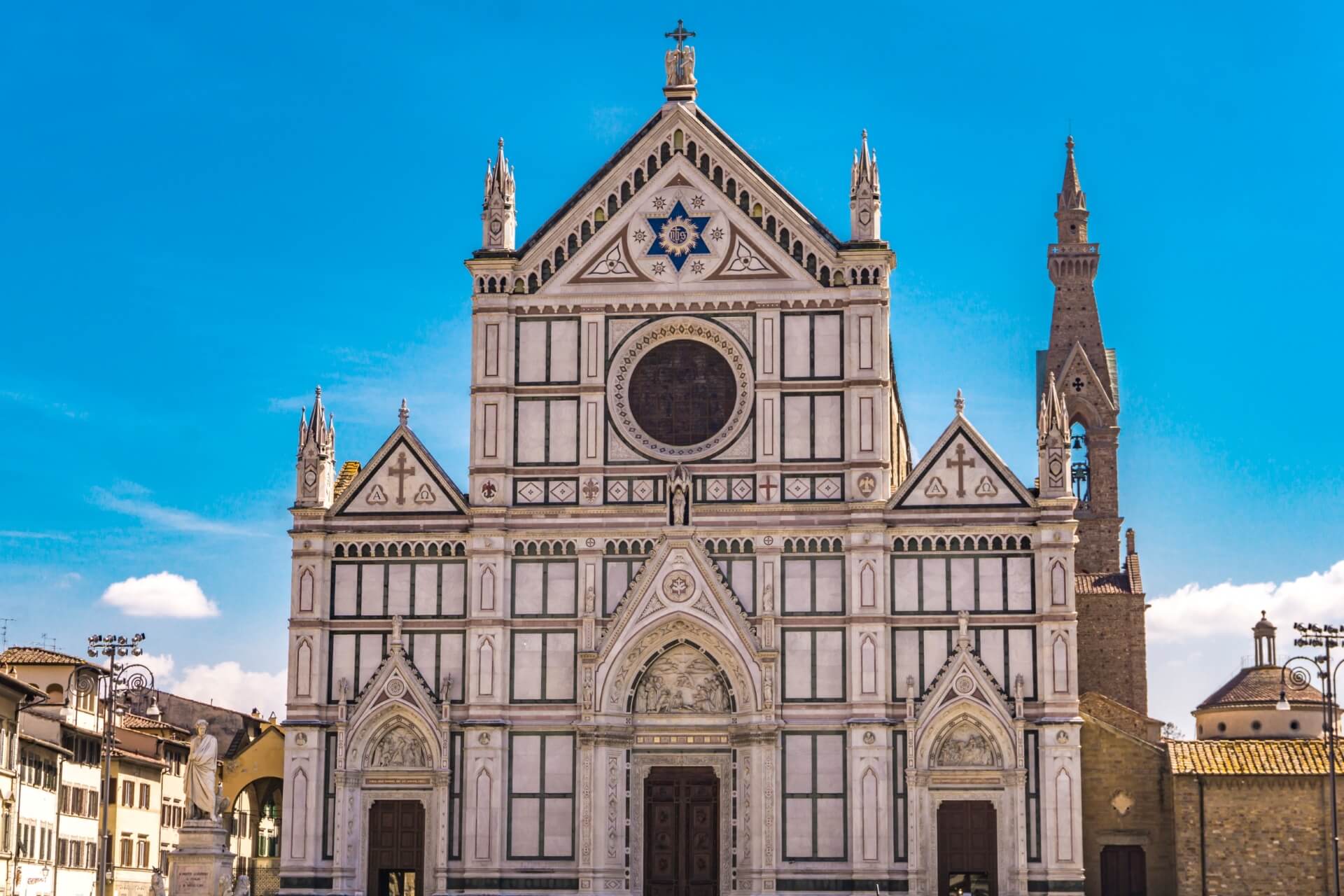
The restored Gothic facade of the church, consecrated by Pope Eugene IV in 1442, attracts attention with its architectural elements. Among them are the sunlit central nave and numerous stained glass windows (some over 700 years old). These windows illuminate the church’s interior in various shades. An unusual decorative element in the form of the Star of David reminds us of the facade’s designer, the Jewish Niccolò Matas. The Basilica or “Church of the Holy Cross” has the shape of a T-shaped cross. The length of the church’s main nave is 115 meters. It is the largest Franciscan church. The church has 16 chapels, decorated with frescoes by famous masters of the country from different times.
The church’s facade is a true, expensive work of art made of multicolored marble elements. The church’s main feature is the numerous tombs of great Italian people. Their names are forever inscribed on the tombs containing their remains, forming the Pantheon of Florence. Galileo, Michelangelo Buonarroti, Dante Alighieri, Niccolò Machiavelli, Gioachino Rossini, Enrico Fermi, and many other great figures (about 300) rest on marble beds with their figures on the sarcophagi.
Each tomb has an arch supported by columns. Together with unique frescoes, sculptures, and paintings, the tombs form the church’s unrivaled wealth, creating an atmosphere of eternal peace. Address: Piazza Santa Croce, 16. The church is open daily from 9:30 AM to 5:30 PM. On holidays and Sundays, it operates from 2 PM to 5 PM. The entrance fee is 8 € for adults and 6 € for children over 11 years old. There is a family ticket costing 8 €.
Basilica of San Lorenzo
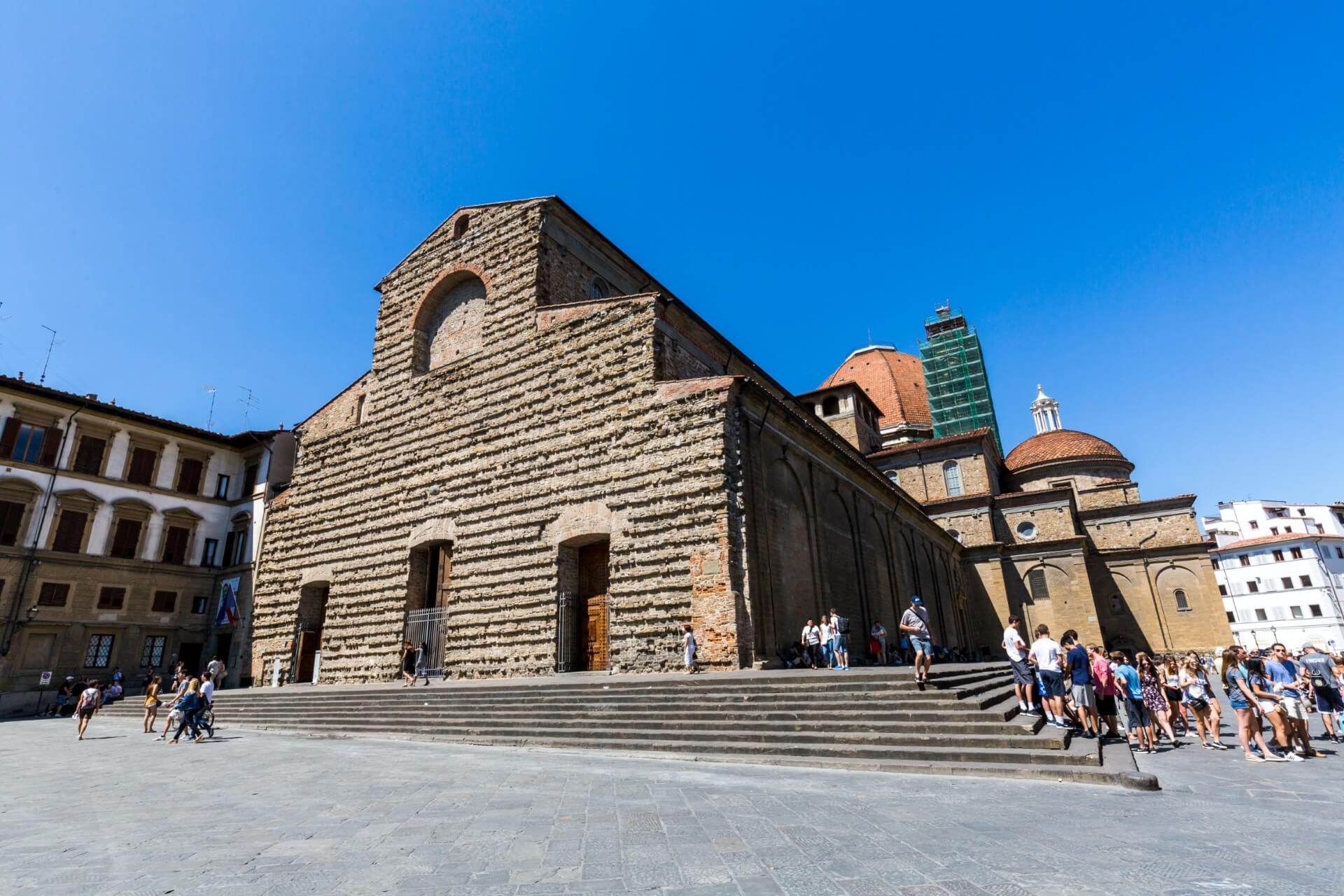
A small church built in honor of Saints Lawrence and Zenobius stood on this site as early as the 4th century. The church served as Florence’s cathedral until the 7th century, after which the title passed to the Cathedral of Santa Maria del Fiore. In the 16th century, the wealthy Medici family began rebuilding the church as a family mausoleum. The works of great masters in architecture, sculpture, and painting embodied their ideas in the new church’s exterior and interior.
Among them are the Old Sacristy created by Filippo Brunelleschi and the New Sacristy resulting from Michelangelo Buonarroti’s genius. Historians say that Michelangelo could not finish the basilica’s facade according to his plans. The church’s interior far exceeds the exterior in beauty and wealth. The floor’s intricate mosaic pattern and the starry sky created on the ceiling fill the church’s atmosphere with a magical essence. The family’s tombs and sarcophagi, adorned with interesting sculptures, harmoniously complement it. You can also see the Chapel of the Princes and the ancient Laurentian Library in the church.
Address: Piazza di San Lorenzo, 9. The church is open to visitors from Monday to Saturday (10:00 AM to 5:00 PM). The entrance fee is 4.5 € for the church, 3 € for the library, and 8 € for the Medici Chapel. A combined ticket costs 8 €.
Church of Santa Trinita
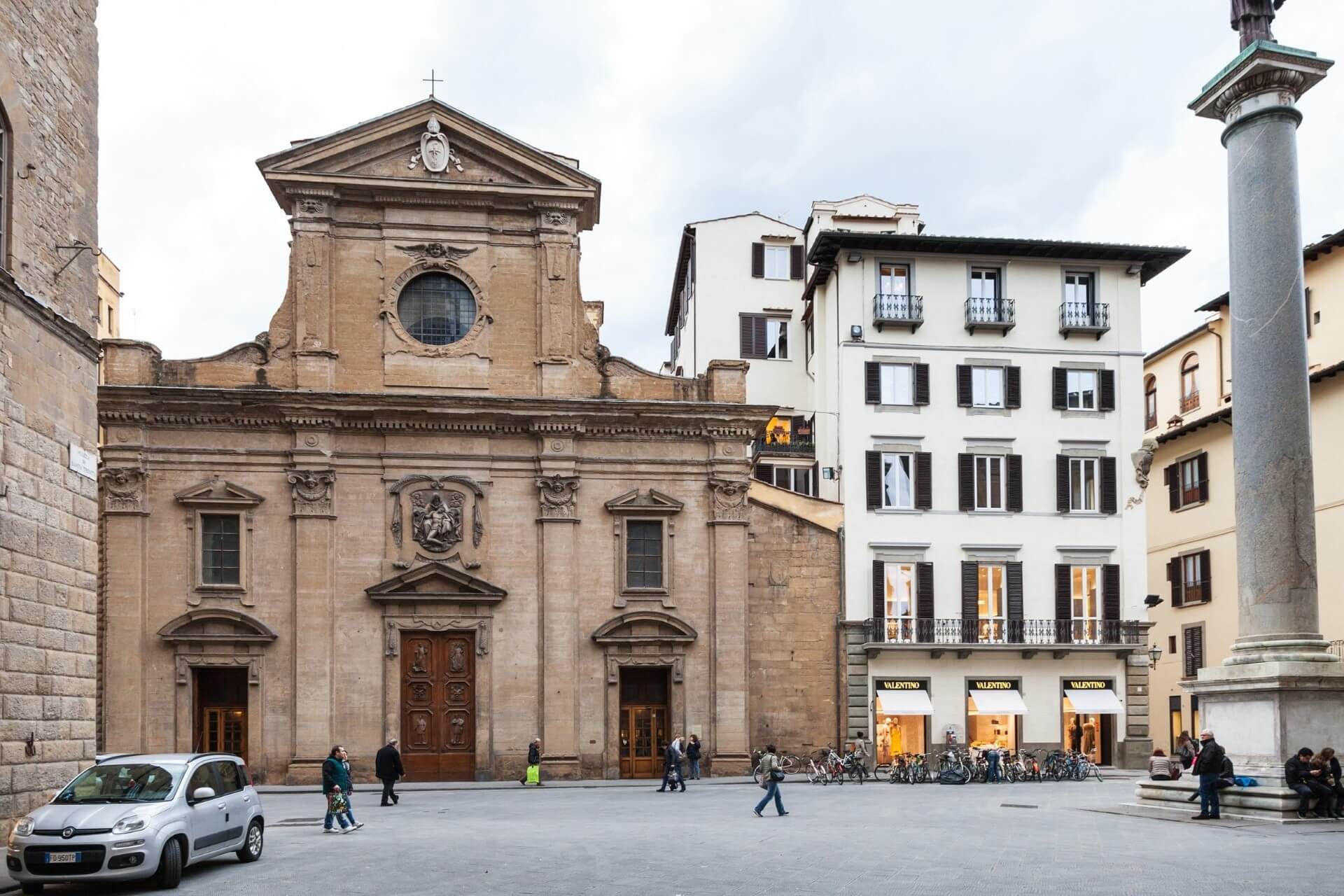
A small structure with a simple facade hides a free museum of medieval masterpieces created by painters Ghirlandaio and Mariotto di Nardo. His famous “Trinity” adorns the main altar of the church. All chapels (oratories) are painted by renowned artists. The central part of the church is decorated with a painting dedicated to Christ’s birth, “Adoration of the Shepherds.” Ghirlandaio’s unique creations have always drawn great interest, increasing their value. This was well understood by the monks of the Vallombrosian Order (practicing asceticism), who owned the ancient church.
The church was built in 1280. It was repaired and rebuilt many times. In the 16th century, a bas-relief of the Holy Trinity appeared on the building’s facade. Much later, the church was adorned with a door depicting saint monks, and a cozy courtyard with arcades was formed. The basilica’s chapels are of great value. The church combines various architectural styles, preserving Gothic elements. Today, the church is a Catholic basilica and is considered one of Florence’s oldest churches.
Address: Santa Trìnita, Holy Trinity Church.
Church of Santa Maria del Carmine
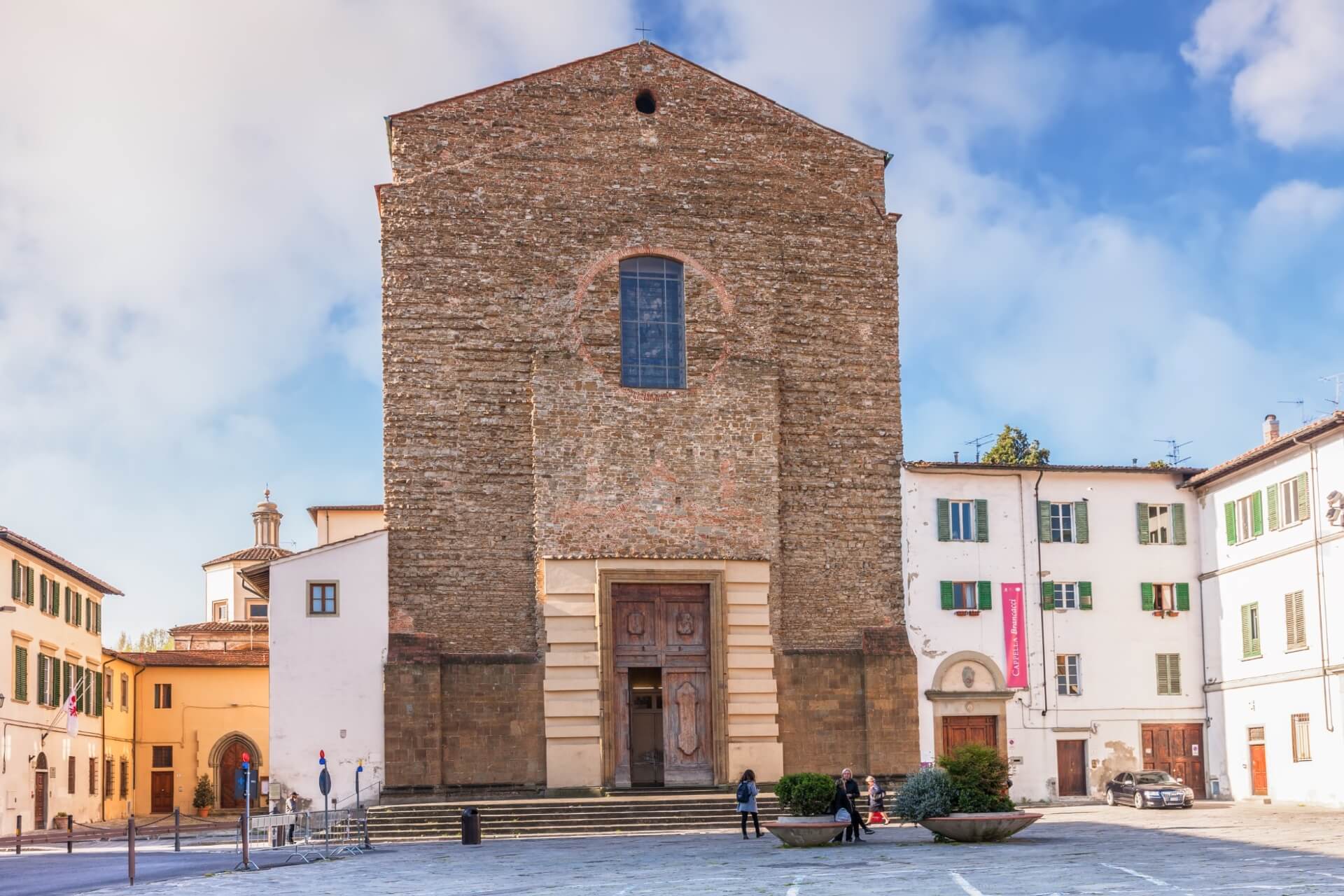
A small church built in honor of the Madonna by the Carmelites in 1268 is considered an attraction of ancient Florence. Five towers, a small window, and a simple facade hide the church’s exceptionally beautiful interior. Constant changes introduced Baroque and Rococo elements into the church’s Romanesque-Gothic appearance. The ancient frescoes and marble sculptures of the interior have been preserved in their original form. The church has five chapels, monastic rooms. Among them, the Brancacci Chapel is unique.
It is decorated with frescoes depicting the life of the Apostle Peter. “Peter Baptizing the Neophytes,” “Peter Healing the Sick with His Shadow,” “The Tribute Money.” The frescoes were created by famous masters Masaccio and Masolino. Access to the church to see the chapel has been allowed since 1990. Entrance to the church is free. Viewing the Brancacci Chapel frescoes costs 3€. The church complex includes the Corsini Chapel and an active female Carmelite monastery.
Address: Piazza del Carmine, 50124 Firenze.
Basilica of Santo Spirito
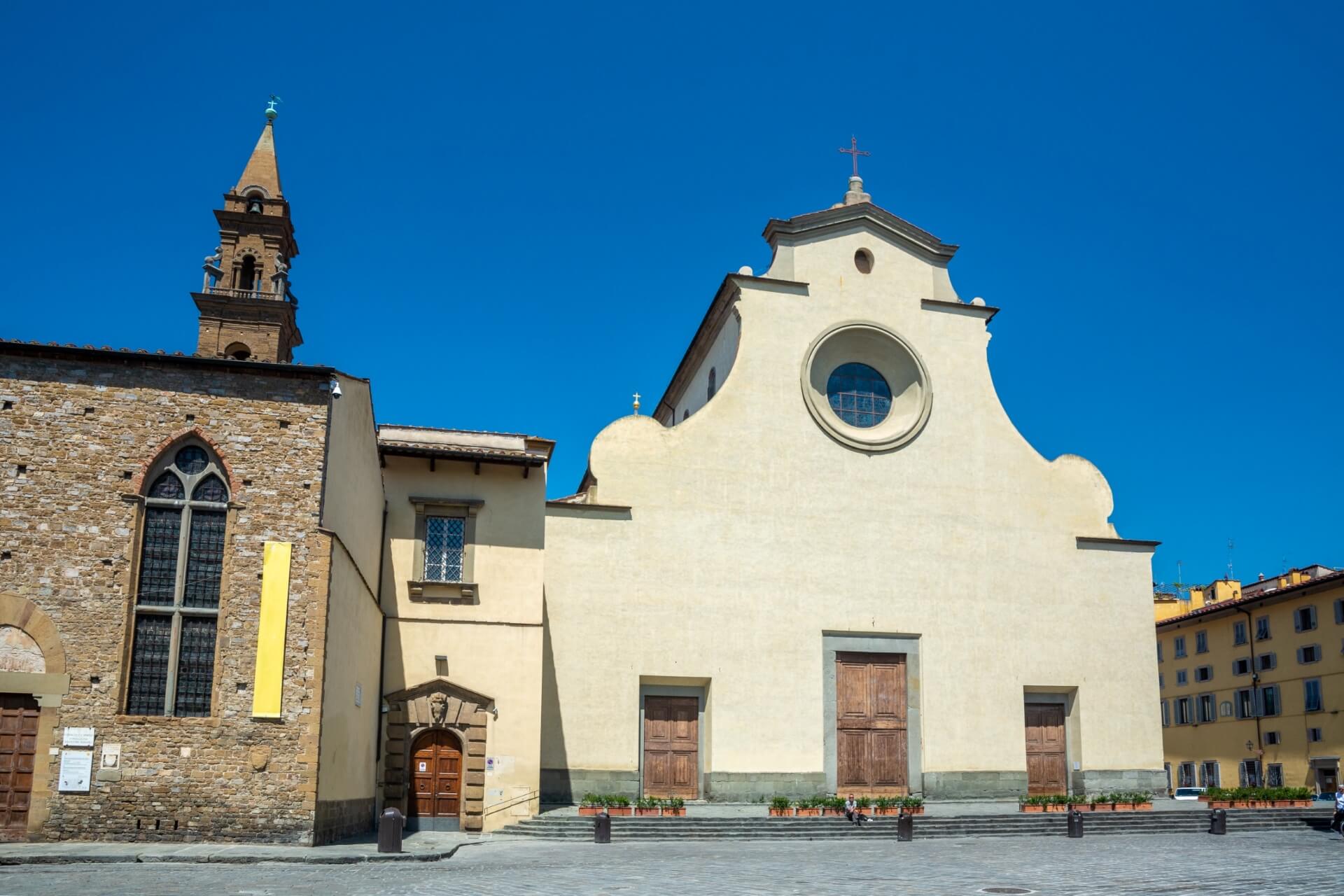
The Church of the Holy Spirit is a late work of the famous Filippo Brunelleschi. It was supposed to become an important element of Florence’s grand urban project. Completing the construction according to the architect’s bold plans was not possible. The early Renaissance church’s construction, like the Basilica of San Lorenzo, took place after the great master’s death. A 13th-century monastery previously occupied the site of the new church (it burned down in 1471). It was considered Florence’s intellectual center. The monastery housed a school, library, almshouse, and dining room for the poor.
The city’s residents dreamed of continuing the good deeds in the new church. The building’s simple, elegant architectural style amazes with its proportions and color scheme. Inside the church are famous paintings such as Michelangelo’s “Crucifixion,” Lippo’s “Madonna and Child with Saints,” and Stradano’s “Expulsion of the Money-changers from the Temple.” The architectural complex includes the Cronaca’s portico, two cloisters, and Sangallo’s sacristy. At the church’s entrance is the Romano Foundation Museum. It holds the painting “The Last Supper” by Andrea Orcagna.
Address: Via Porta Aurea, 48121 Ravenna RA.
Basilica of San Miniato al Monte
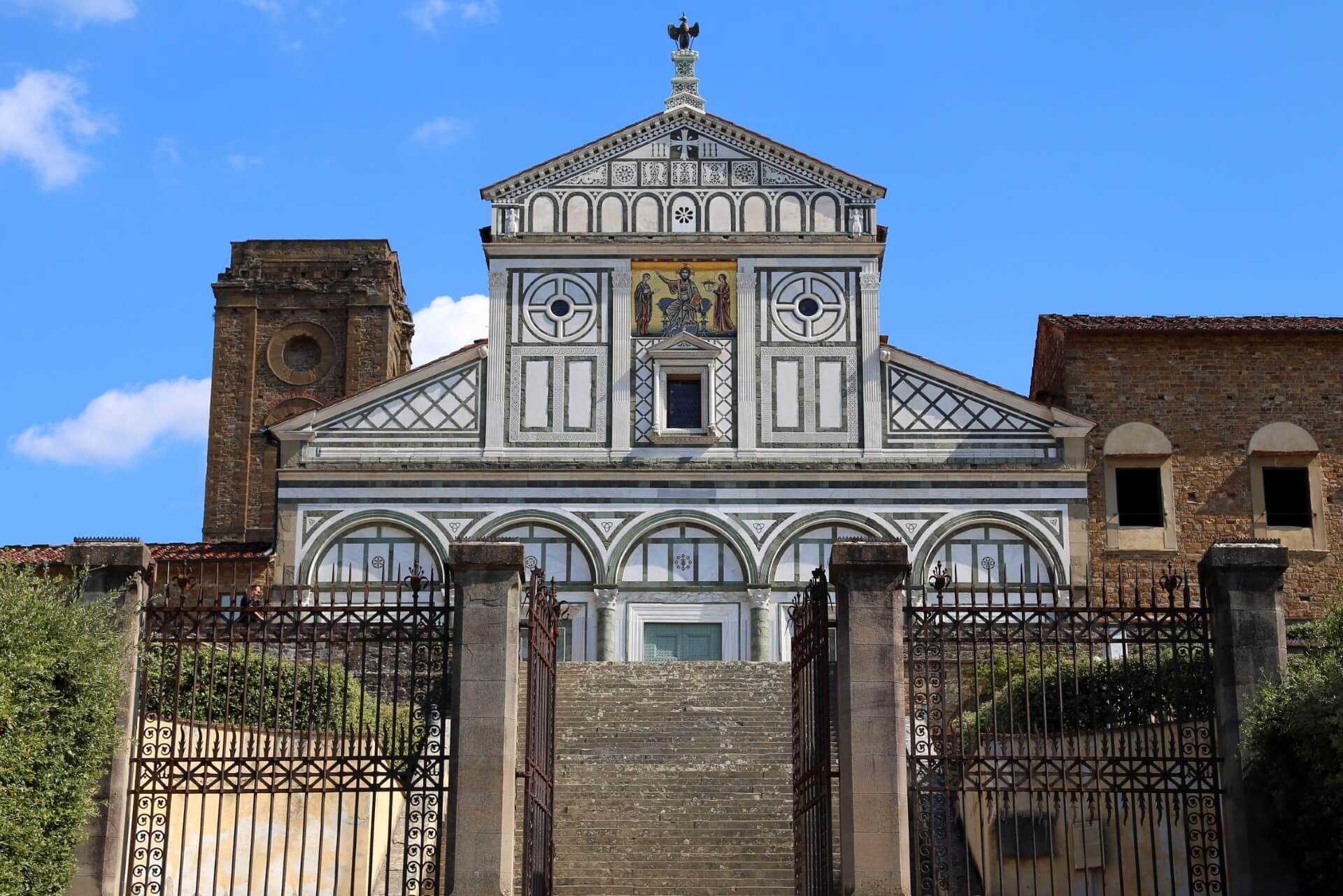
On one of Florence’s high hills lies an ancient basilica, preserving architectural elements of the best examples of Italian buildings in the traditional Romanesque style. According to legend, this was the site of a chapel (cave) where the first Florentine martyr Miniato (Minas, of Armenian origin, who appeared in Italy in 250) died. Gradually, a monastery was built next to the church, designed by Michelangelo and handed over to the Benedictine Order. It was later rebuilt, and fortress walls appeared. Local monks still offer their famous liqueurs, herbal infusions, and honey.
The church’s facade, decorated with rare multicolored marble tiles, is considered a model of Tuscany’s ancient style. The modern lighting system makes the facade shimmer and shine, highlighting the beautiful inlaid pattern of the pediment and the ancient mosaic “Christ between the Madonna and Saint Miniato,” created in the 12th century. The church’s interior has preserved the Romanesque-Florentine style: the central part of the floor is decorated with a beautiful marble mosaic with zodiac signs and symbolic animal figures. The church’s walls retain ancient frescoes. Of interest are the basilica’s crypt, presbytery pulpit, Chapel of Saint James, and Chapel of the Crucifixion. Near the church is the cemetery with the grave of the famous writer Carlo Collodi, the creator of Pinocchio.
Address: Via delle Porte Sante, 34, 50125 Firenze. The basilica opens at 7:00 AM with a service. Tourist entry is allowed from 9:30 AM to 7:00 PM from Monday to Saturday. Admission is free, and donations of 1, 2 € are welcome.
Church of Santa Felicita
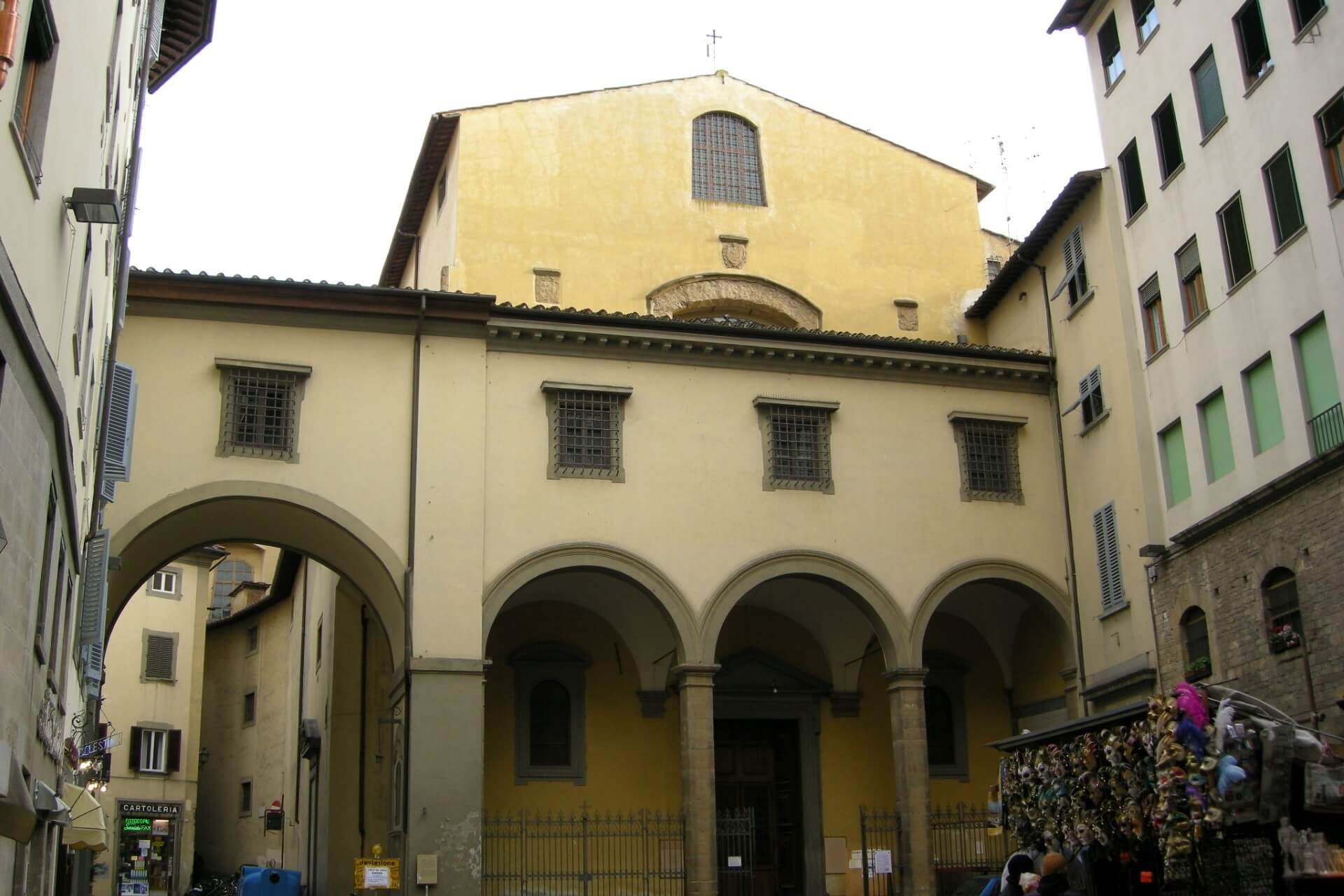
From the ancient church built in honor of Saint Felicita in the 4th century, only a few elements have been preserved. Among them are the altar’s paintings “Deposition from the Cross, Lamentation,” and the dome’s decoration “Four Evangelists” by the famous Italian painter Jacopo Pontormo. The construction of the new Gothic church began after the end of the plague epidemic. It was consecrated in 1354. Now, one can only see the Chapter Hall with Gerini’s painting. The modern church “Holy Happiness” appeared in the 18th century.
The Canigiani and Capponi chapels, the 17th-century choir, and the sacristy have been preserved. You can see interesting collections of paintings, such as “Madonna and Child,” “Annunciation,” “Birth of Jesus,” and “Meeting of Saint Anne and Saint Joachim”. These works were created by Volterrano, Ghirlandaio, Lorenzo, and Gaddi. The oldest church in Florence is located on the square of the same name. It is open to visitors from 9:00 AM to 8:30 PM.
Baptistery of San Giovanni
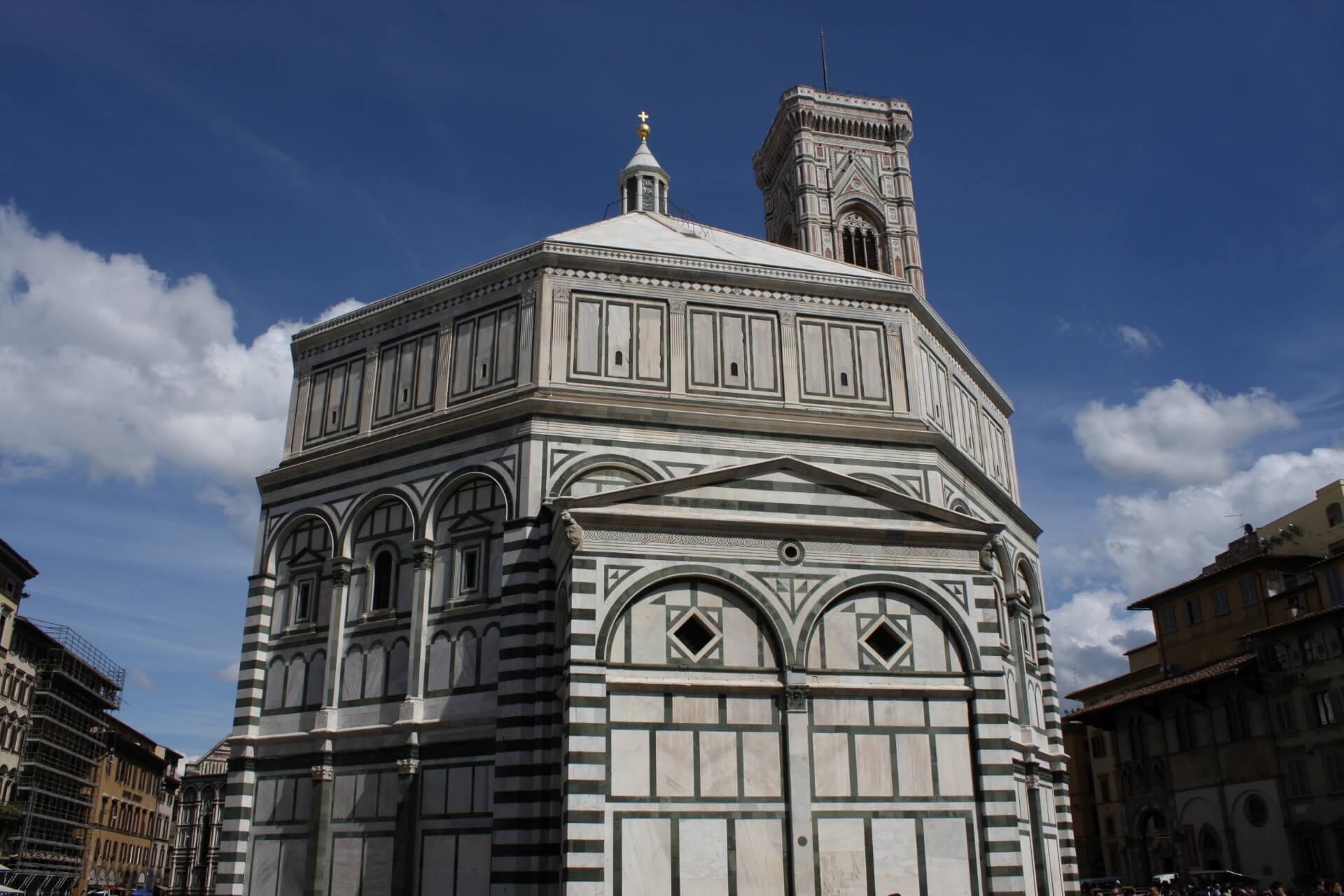
The ancient building is one of Florence’s main attractions, adorning Cathedral Square. Legends say that a temple dedicated to Mars stood here in the 1st century. Only in the 9th century did the rebuilt building in the shape of a perfect octagon become a Romanesque basilica. The church received the status of a baptistery (place of baptism) in 1128. For another hundred years, it also served as the Cathedral. Until the 9th century, the baptistery was where members of famous families like the Medici, Dante, hundreds of famous names of the country, and thousands of commoners accepted the Catholic faith.
To allow parishioners to participate in the baptismal ceremony, the building has three pairs of doors. They are now a particular value of the baptistery. For example, the surface of the South Doors is adorned with 28 scenes from the life of John the Baptist, created by the famous master Pisano. The East Doors feature 10 illustrations from the Old Testament history, also known as the “Gates of Paradise.” The North Doors display gilded reliefs of New Testament scenes in Gothic style.
The baptistery’s interior decoration is stunning and valuable. It includes a snow-white marble dome painted by various Italian masters. The majestic image of Jesus, frescoes depicting scenes of the Last Judgment, Holy Scripture, and the Celestial Hierarchy. The frescoes decorating the baptistery’s pulpit are considered the most beautiful in Tuscany. The famous baptismal font is also located here, an essential element of the baptismal ceremony for nine centuries.
Address: Piazza del Duomo. It operates from 11:15 AM to 6:30 PM. The entrance fee is 5 €.
Church and Monastery of San Marco
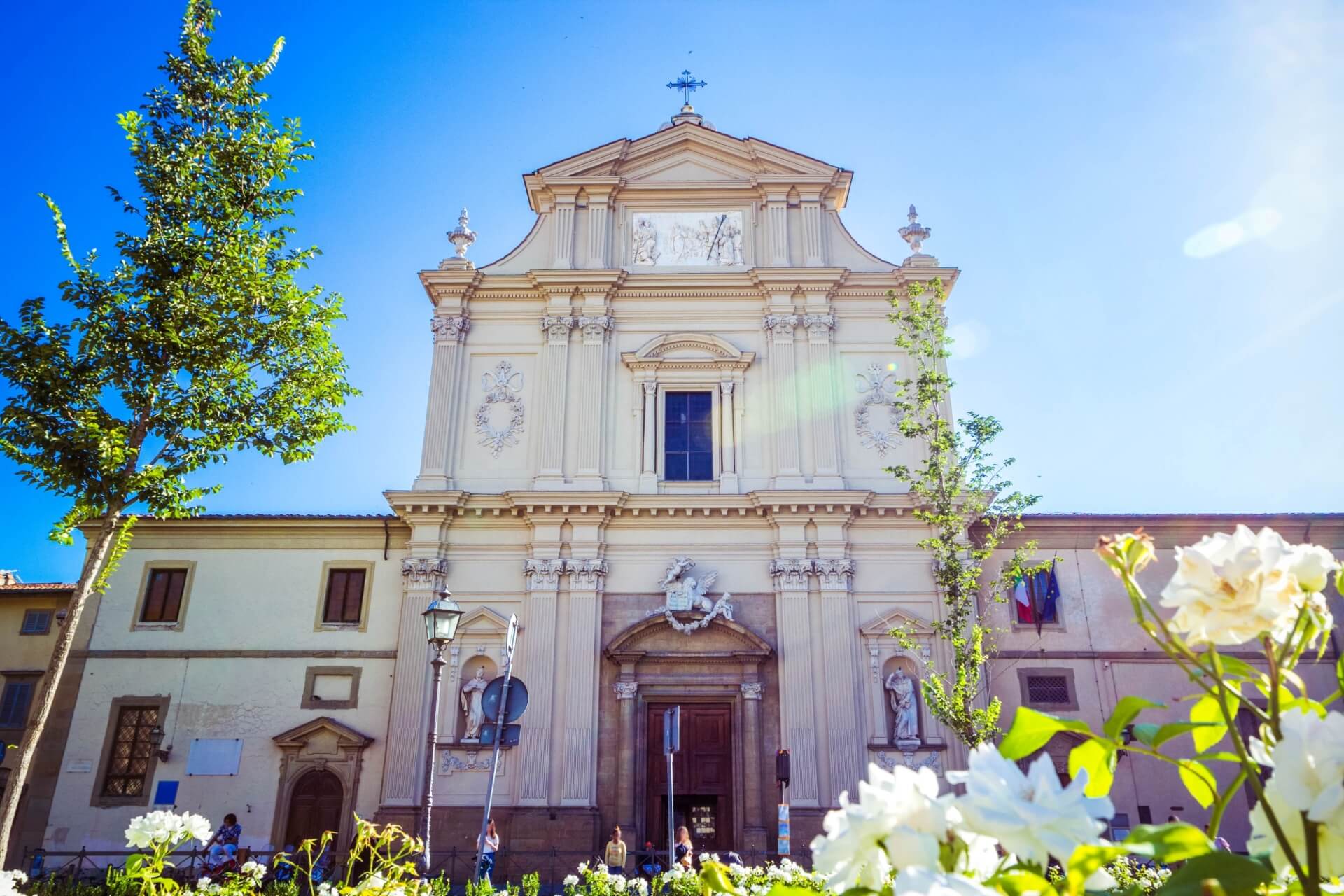
The complex comprises the Church of San Marco and the women’s monastery (now a museum). The church was consecrated in 1443. In 1498, Dominican priest Savonarola served as its abbot. You can see the cell where he lived and his portrait. The monastery building was the first in Florence with elegant proportions of Renaissance architectural elements.
The monastery’s frescoes were created by Beato Angelico. They decorate the cells, corridors, and other monastery rooms. Many works of Italian masters of the Early Renaissance have become world-class masterpieces, attracting the attention of admirers. The monastery has been closed since 1866. It now houses the Beato Angelico Museum, named after the famous 15th-century painter.
The museum includes a library with a large collection of ancient manuscripts. The organization of work in the library is interesting. Without the permission of specially elected executors, the use of manuscripts was prohibited. Every year, monks took inventory in their presence. When a book was missing, the monks created a fresh manuscript. You can visit the complex at Piazza San Marco, 1-3, from Monday to Friday, from 8:15 AM to 4:50 PM. The ticket costs 4 €.
Conclusion
Florence, the star of the Renaissance, is a city that captivates visitors with its rich history, stunning architecture, and world-class art. From the grandeur of the Cathedral of Santa Maria del Fiore to the serene beauty of the Basilica of San Miniato al Monte, the city’s churches and temples offer a glimpse into Florence’s glorious past. Whether you spend your days exploring the city’s museums, admiring its frescoes, or simply strolling through its charming streets, Florence promises an unforgettable journey through time and art.

